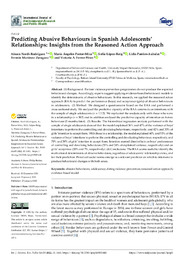Título :
Predicting Abusive Behaviours in Spanish Adolescents Relationships: Insights from the Reasoned Action Approach |
Autor :
Nardi-Rodríguez, Ainara 
Pastor-Mira, María Ángeles 
López Roig, Sofía 
Pamies-Aubalat, Lidia 
Martínez-Zaragoza, Fermín 
Ferrer-Perez, Victoria A.  |
Editor :
MDPI |
Departamento:
Departamentos de la UMH::Ciencias del Comportamiento y salud |
Fecha de publicación:
2022-01-27 |
URI :
https://hdl.handle.net/11000/33517 |
Resumen :
Background: Partner violence prevention programmes do not produce the expected
behavioural changes. Accordingly, experts suggest applying evidence-based behavioural models to
identify the determinants of abusive behaviours. In this research, we applied the reasoned action
approach (RAA) to predict the performance (boys) and acceptance (girls) of abusive behaviours
in adolescents. (2) Method: We designed a questionnaire based on the RAA and performed a
cross-sectional study. We analysed the predictive capacity of the RAA constructs on intentions with
the sample of single adolescents (n = 1112). We replicated the analysis only with those who were
in a relationship (n = 587) and in addition analysed the predictive capacity of intention on future
behaviour (3 months later). (3) Results: The hierarchical regression analysis performed with the
sample of single adolescents showed that the model explained 56% and 47% of the variance of boys’
intentions to perform the controlling and devaluing behaviours, respectively; and 62% and 33% of
girls’ intention to accept them. With those in a relationship, the model explained 60% and 53% of the
variance of boys’ intentions to perform the controlling and devaluating behaviour, respectively, and
70% and 38% of girls’ intention to accept them. Intention exerted direct effects on boys’ performance
of controlling and devaluing behaviours (31% and 34% of explained variance, respectively) and on
girls’ acceptance (30% and 7%, respectively). (4) Conclusions: The RAA seems useful to identify the
motivational determinants of abusive behaviours, regardless of adolescents’ relationship status, and
for their prediction. Perceived social norms emerge as a relevant predictor on which to intervene to
produce behavioural changes with both sexes.
|
Palabras clave/Materias:
abusive behaviours
adolescence
dating violence
prevention
reasoned action approach
evidence-based model |
Área de conocimiento :
CDU: Filosofía y psicología: Psicología |
Tipo de documento :
info:eu-repo/semantics/article |
Derechos de acceso:
info:eu-repo/semantics/openAccess
Attribution-NonCommercial-NoDerivatives 4.0 Internacional |
DOI :
https://doi.org/10.3390/ijerph19031441 |
Publicado en:
International Journal of Environmental Research and Public Health 2022, 19(3), 1441 |
Aparece en las colecciones:
Artículos Ciencias del Comportamiento y Salud
|
 La licencia se describe como: Atribución-NonComercial-NoDerivada 4.0 Internacional.
La licencia se describe como: Atribución-NonComercial-NoDerivada 4.0 Internacional.
.png)
